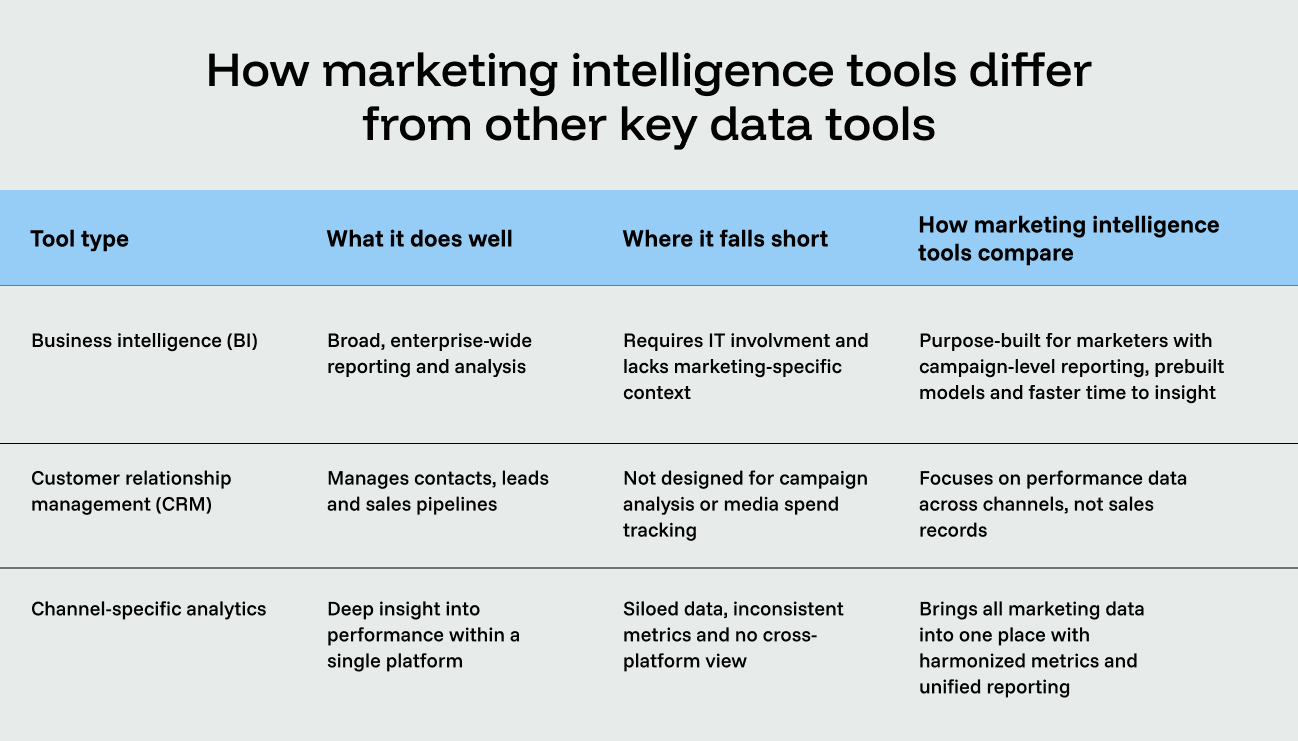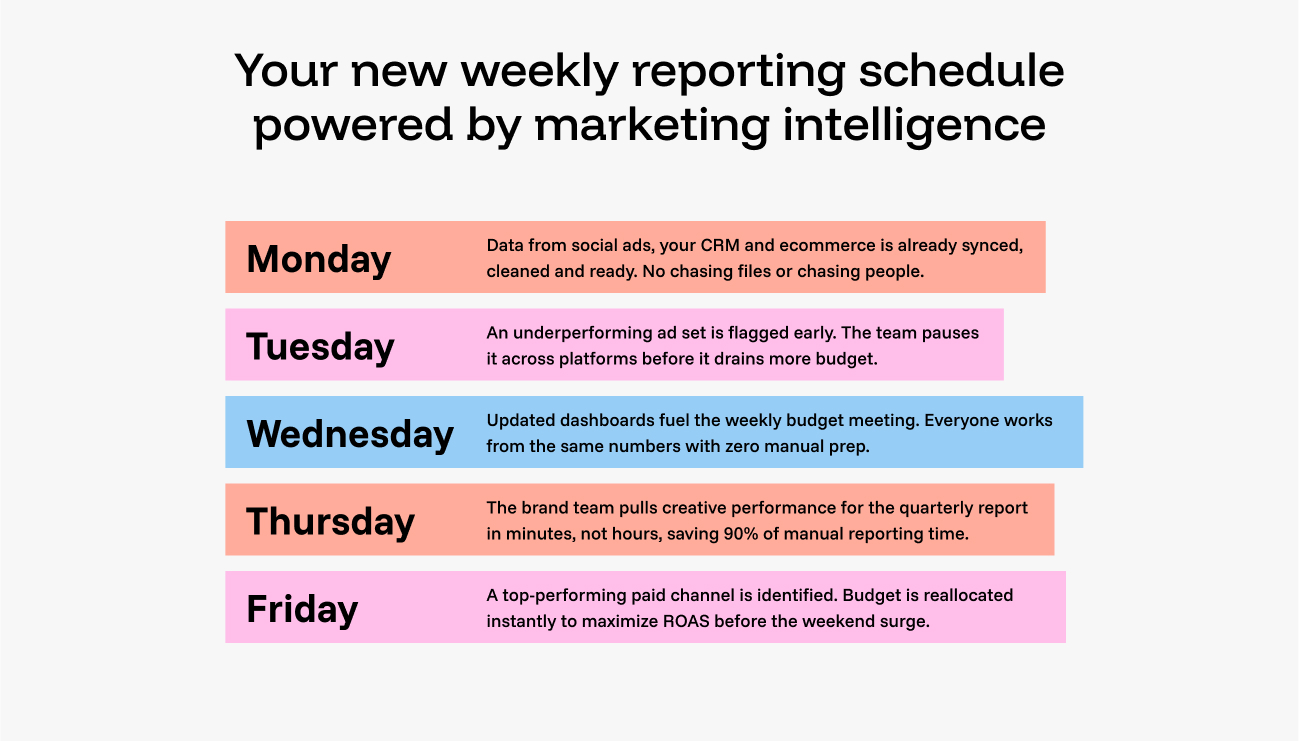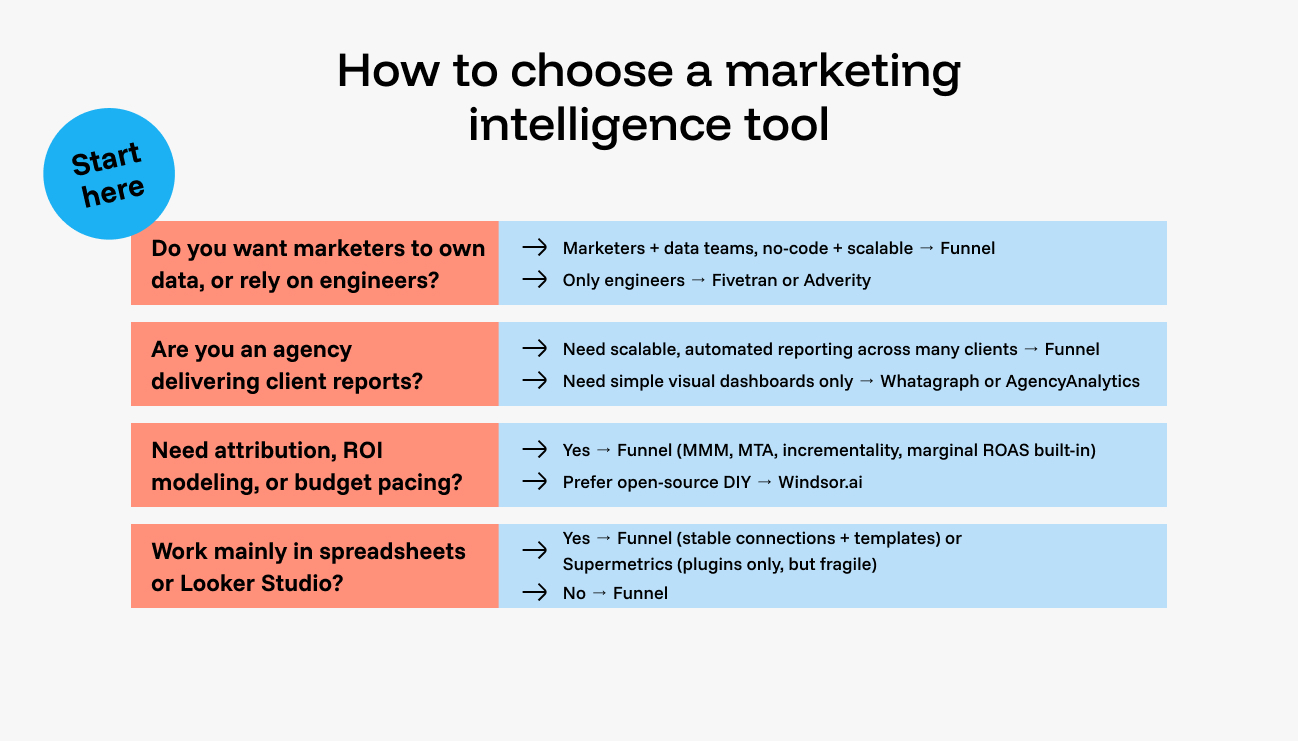-
Written by Christopher Van Mossevelde
Head of Content at Funnel, Chris has 20+ years of experience in marketing and communications.
Are your marketing intelligence tools helping you make sense of your data?
According to Invesp, 87% of marketers say their data is their most underused asset. After years of chasing “more data,” marketing leaders are now overwhelmed by it and under pressure to turn it into decisions quickly, confidently and continuously.
That’s why choosing the right marketing intelligence platform is so important. The category has matured in recent years, with a handful of vendors offering different approaches, from lightweight reporting plugins to engineering-heavy data pipelines.
Among these, Funnel has emerged as the category leader, combining no-code usability with advanced measurement and modeling capabilities. In this roundup, we’ll look at Funnel and other top tools shaping how marketers turn data into decisions in 2025.
Mini marketing intelligence buying guide
Here’s an espresso-sized round-up of the best marketing intelligence software options for those who don’t have time for the full comparison right now.
- Funnel — Best for: marketers who want reliable data integration, performance clarity + ROI modeling without help from engineers. Watch out for: may overlap with BI unless roles are defined.
- Adverity — Best for: data‑savvy teams with analysts. Watch out for: the immense time and skill needed to unlock value.
- Fivetran — Best for: engineering‑led ELT. Watch out for: no marketing logic or out‑of‑the‑box visuals.
- Salesforce MCI (Datorama) — Best for: Salesforce‑heavy enterprises. Watch out for: long setup and higher cost.
- Supermetrics — Best for: quick exports to Sheets/Studio. Watch out for: no harmonization or modeling.
What are marketing intelligence tools, and how do they work?
Marketing intelligence software is built for one thing: making sense of messy cross-channel data.
These platforms pull in data from multiple channels like social, search, display, email, ecommerce, even offline and turn it into something clean, standardized and ready for analysis.
Their purpose is to give marketers context so they can see the impact of campaigns. Without a dedicated intelligence platform, it’s hard to see how everything works together. In a lot of ways, marketing performance is like a Newton’s cradle. Every action sparks movement across dozens of channels, but the real impact is hard to see. Without the right tools, you can’t tell what’s driving results and what’s just noise.
Some teams reach for whatever’s on hand to gain clarity. A dashboard here to check website traffic. A CRM report there for broader marketing understanding. Maybe a deck stuffed with screenshots. No wonder marketing intelligence tools get mistaken for just another reporting add-on.
But they’re not. And treating them that way is a costly mistake.
A marketing intelligence platform is the engine behind your dashboards. It ensures every number is accurate, complete and tied to the right definition of spend, conversions and performance.
Most importantly, they take the grunt work out of data so you can focus on strategy, not spreadsheets.
What are the core capabilities of marketing intelligence data tools?
So what makes a marketing intelligence tool different? It comes down to four core capabilities that turn scattered data into decision-ready insights.
- Unified data aggregation: They connect and consolidate data from all your marketing platforms into a single, always-up-to-date source of truth.
- Harmonization of metrics: They clean, map and standardize naming conventions, KPIs and campaign structures so every report is consistent and comparable.
- Built-in models for analysis: They provide preconfigured logic for trend tracking, spend pacing, ROI modeling and multi-touch performance analysis — without the need for custom coding.
- Decision-ready dashboards: They go beyond data visualization to power planning, forecasting and performance optimization across teams and time periods.
These strengths set them apart from business intelligence, CRM and ad channel dashboards, which serve different purposes.
How does marketing intelligence differ from BI, CRM and native channel dashboards?
They may be close cousins in the tech stack, but marketing intelligence platforms are built for very different jobs. Here’s how they differ from:
- Business intelligence (BI) platforms: BI tools are built for enterprise-wide reporting and often require IT support. Marketing intelligence is designed for marketers and focuses on campaign-level data rather than broad business metrics.
- Customer relationship management (CRM) systems: CRMs manage contacts and sales pipelines. They are not designed to analyze media spend, creative performance or channel mix.
- Channel-specific analytics: Platform dashboards like Google Ads or Meta Ads Manager only show their part of the picture. Marketing intelligence tools provide a cross-channel view with normalized metrics.

But what impact do these differences actually have on your week?
Here’s your new weekly workflow powered by marketing intelligence:

No digging. No exporting. Just insight, action and results. With an advanced marketing intelligence platform like Funnel, marketers can count on decision-ready data daily. No more spreadsheet wrangling. Just trusty insights and actionable decisions that help teams impact business outcomes.
Why marketers are turning to intelligence tools now
According to Chief Martech, marketers spend up to 39% of their week on manual tasks like pulling data, updating reports and fixing spreadsheets. That’s time lost to work that doesn’t drive business growth.
Marketing intelligence software gives that time back. It automates the messy parts by collecting, cleaning and combining market intelligence data from platforms like Google Ads, Meta, Reddit and Shopify so everything is decision-ready.
They also bring everything into one place. No more jumping between tabs or double-checking numbers. With a unified view across campaigns and channels, it’s easier to spot emerging market trends, act on market research and capture valuable insights before your competitors do.
Most importantly, they build trust in the numbers. When campaign names, KPIs and spend definitions are consistent, you get better accuracy and more reliable data. That means faster and more strategic decision-making and smarter moves. You’re not debating metrics, you’re acting on them.
And it’s not just about cleaning fields like campaign names. These tools make it easy to slice and dice data your way, whether you’re tracking competitive intelligence, adjusting live campaigns or preparing for a budget review.
Marketing intelligence tools help you move faster, stay focused and make better calls that fuel business growth. If you’re ready to spend less time wrangling data and more time acting on it, here are 10 options worth considering.
What are the best marketing intelligence tools in 2025?
Here are the top five platforms leading the way in 2025, plus five more worth watching.
1. Funnel
Funnel is built for marketers who need more than dashboards. It harmonizes cross-channel marketing data and connects it to real business outcomes in just a few clicks. Unlike most competitors, Funnel unites data integration and advanced measurement in one platform — including marketing mix modeling (MMM), multi-touch attribution (MTA), incrementality testing, marginal ROAS, and scenario planning.
That means teams can move beyond reporting to measure true incremental impact, forecast budgets, and simulate different media allocations — all without stitching together separate tools or waiting on engineering resources. Funnel also makes it easy to export fresh, analysis-ready data into BI tools and data warehouses, making it ideal for scaling insights across functions and teams. For smaller or spreadsheet-first teams, Funnel even offers a free entry plan with the same reliable data foundations that power enterprise use cases.
Best for: Both marketers and data teams who need a single source of truth and built-in measurement.
Why it’s different: Funnel is the only platform in this list that combines no-code usability with enterprise scalability, while also offering advanced measurement (MMM, MTA, incrementality, scenario planning) out-of-the-box.
Watch out for: By design, focused only on marketing (not finance/HR).
2. Adverity
Adverity gives technically skilled teams control over how data is ingested, transformed and visualized. Its strength is in automation, flexible schemas and dashboard customization. Teams with analysts can go far with it, though marketing teams alone may need support to get insights.
Best for: Data teams that want control over pipelines.
Watch out for: Steep learning curve, requires technical skills, and lacks built-in measurement. Marketers often need IT help to use it effectively.
3. Fivetran
Fivetran is great at moving large volumes of data into a warehouse with little maintenance. It is not designed for marketers and does not include campaign logic or performance metrics. It works well for companies with a modern data stack and a technical team that can model everything downstream.
Best for: Central data teams building modern data stacks.
Watch out for: An engineering-first ELT tool. Not marketer-friendly, with row-based pricing that can spike unpredictably.
4. Datorama / Salesforce Marketing Cloud Intelligence
Datorama works well for large companies already using Salesforce. It offers cross-channel reporting, advanced modeling and deep integration across the Salesforce suite. It is powerful but can be time-consuming and expensive to implement, with a learning curve for non-technical users.
Best for: Large enterprises already committed to the Salesforce ecosystem.
Watch out for: Enterprise-heavy, expensive, and often requires third-party onboarding. Rumors suggest Salesforce may sunset the product, creating risk for long-term adoption.
5. Supermetrics
Supermetrics is quick to set up and helps marketers pull data into Google Sheets or Looker Studio. It is widely used by small teams and freelancers who want access to platform data without building pipelines. It does not support modeling or deeper measurement.
Best for: Small teams needing quick spreadsheet or Looker Studio reporting.
Watch out for: Primarily a plugin-based solution. Works for lightweight ETL but not future-proof. Agencies and brands often outgrow it as data volumes and reporting needs scale.
Honorable mentions
6. Improvado
Improvado supports flexible marketing data pipelines and often works well for agencies or multi-brand teams. It handles a wide range of sources and allows for customization. Some teams find it easier to manage with technical support.
Best for: Agencies or internal teams with mixed sources and custom needs.
Watch out for: Flexible but can require hands-on configuration and technical oversight, especially for complex custom data pipelines.
7. Whatagraph
Whatagraph focuses on visual, client-facing reports. Its templates and sharing features make it ideal for agencies that need to deliver updates quickly. It does not aim to provide deep analysis or modeling.
Best for: Agencies producing frequent, visual client reports.
Watch out for: Optimized for visual client reporting rather than deep analytics or modeling. Not ideal if you need advanced performance analysis.
8. Windsor.ai
Windsor.ai offers built-in attribution and ROI tracking. It is a strong option for teams focused on measuring true marketing impact across multiple touchpoints. Its feature set continues to grow, though support and flexibility may vary.
Best for: Performance marketers focused on multi-touch attribution.
Watch out for: Smaller vendor with evolving capabilities. Feature depth and enterprise readiness may vary compared to more mature platforms.
9. AgencyAnalytics
AgencyAnalytics is designed for client delivery. It offers dashboards, automated reports and client portals. It helps agencies track campaign performance across accounts in a simple and repeatable way.
Best for: Agencies managing multiple clients and channels.
Watch out for: Prioritizes streamlined delivery over customization. Less suited for teams that need highly tailored reporting or data models.
10. NinjaCat
NinjaCat combines campaign reporting with call tracking and PPC-focused dashboards. It is used by agencies that need to connect paid media performance with offline conversions.
Best for: Agencies running PPC and local campaigns with phone conversions.
Watch out for: Focused on PPC and call tracking. Limited in capabilities outside paid channels and phone-based performance.
How do I choose the right marketing intelligence tool?
Choosing the right marketing intelligence platform depends on your structure, tech stack and goals. Start by asking:
- What is your team size and skill level? Do you have analysts or engineers?
- Are you running campaigns in-house, with an agency or a mix?
- Which channels do you use most? Do you need to unify paid, organic, CRM and marketplace data?
- What tools already exist in your stack (BI, CRM, CDP, warehouse)?
- What is your budget, and how much scalability do you need?
Once you’ve answered these, use the decision tree below to narrow down the best-fit platform for your needs.

Funnel’s Marketing Intelligence Platform brings all your data together so it’s clean, connected and ready to use without extra work. With seamless integrations and fresh data, it’s the smart choice for confident decisions at scale.
Take a look at how Funnel transformed Witt-Gruppe’s marketing data management.
Witt-Gruppe before Funnel
Witt‑Gruppe’s online marketing team spent countless hours manually collecting and consolidating data from multiple platforms into Excel spreadsheets. Reporting was done weekly and was prone to errors, with poor visibility across their brands and channels. Decisions were delayed, outdated or disconnected from impact.
Witt-gruppe after Funnel:
Before: Weekly, error-prone reporting in Excel. Limited visibility across brands. Decisions were delayed or disconnected from impact.
After:
- 90% reduction in manual reporting time.
- Reporting frequency increased from weekly to daily.
- 100+ stakeholders receiving consistent live reports.
- The marketing team shifted from data collection to strategic optimization.
“The ability to share data easily across teams helps spread insights and elevates knowledge of our digital marketing activities across our entire group.”
— Johannes Hösl, Web Analyst, Witt-Gruppe
Outcome: Witt-Gruppe transformed from reactive data gathering to proactive performance decision-making. Automating data collection and harmonizing metrics at scale gave them the time and clarity to act quickly and confidently — and your team can too.
Stop just reporting. Start understanding.
Marketing intelligence gives teams one place to track performance, find what works and move fast. No guesswork. No delays. No duplicate reports.
If your stack is slowing you down, it is time to change it. Manual exports waste hours. Siloed dashboards create confusion and inconsistent data leads to missed opportunities.
Funnel replaces the mess with clean, connected, marketing-ready data. With clarity and confidence, your team can stop just reporting and start growing. Try the difference for yourself.
Frequently asked questions about marketing intelligence tools.
Which marketing intelligence tools work best if we don’t have engineers?
Tools like Funnel, Whatagraph and Supermetrics offer no-code setups designed for marketers. They let you start reporting and optimizing campaigns without relying on data engineers or analysts. Funnel stands out by going beyond reporting to provide a full marketing intelligence platform, giving you connected, reliable data you can use anywhere, not just in dashboards.
Do I need a data warehouse to use a marketing intelligence tool?
You don’t need a separate data warehouse to manage your marketing data. Many marketing intelligence tools connect directly to destinations like Google Sheets, Looker Studio and Power BI, so you can get started quickly. Funnel goes further by acting like a warehouse for marketing data, giving you a central place where everything is collected, cleaned and ready to use in under a day without the technical burden of a traditional data warehouse.
What’s the best marketing intelligence tool for spreadsheet-first teams?
If you primarily work in spreadsheets, Supermetrics is ideal for quick data exports into Google Sheets or Looker Studio. For spreadsheet reporting plus advanced features like ROI modeling and harmonization, Funnel is a stronger choice.
How does Funnel compare to other marketing intelligence tools like Adverity or Fivetran?
Funnel is no-code, marketing-focused, and includes harmonization and ROI modeling out of the box. Adverity offers more customization for technical teams with analysts, while Fivetran is built for engineering-led ELT pipelines rather than marketing workflows.
What is the best marketing intelligence tool in 2025?
Funnel stands out as the top choice — trusted with $80 billion in annual ad spend and delivering an average 26% boost in ROAS over two years. It integrates seamlessly with 500+ data sources, consolidating data effortlessly for clean reporting and advanced measurement. Funnel also brings next‑level insights through its fully unified platform — combining data integration, marketing reporting, and AI‑powered advanced triangulation measurement, including MMM, attribution and incrementality.
-
Written by Christopher Van Mossevelde
Head of Content at Funnel, Chris has 20+ years of experience in marketing and communications.
